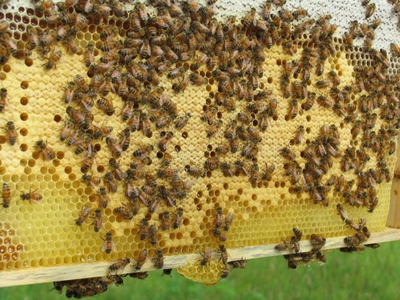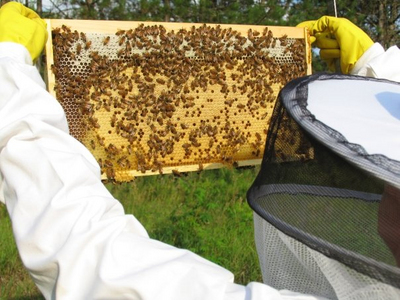The inside buzz on the Ann Arbor Backyard Beekeepers

Honey Bees | Photo courtesy of Maggie Smith
Winn Harless caught 24 swarms of bees last year.
“Three in one day!” he growls.
He fields phone calls from frantic homeowners with swarms clinging to trees, fences and patio furniture. Harless, who’s in his 60s or 70s, jumps in his pickup and races to the scene dressed in jeans and a button-down shirt, which he tucks tightly into his pants.
At the scene he lays down a white sheet and a portable hive, then uses a bucket on a long metal pole to dislodge honeycomb and thousands of bees. The process takes a little while. Harless estimates that most of his swarms weigh upwards of four pounds. That’s around 18,000 bees.
“It’s tough to get people to take pictures for me,” he tells a meeting of the Ann Arbor Backyard Beekeepers in a classroom at the Matthaei Botanical Gardens.
The Ann Arbor Backyard Beekeepers (A2B2) is an informal group of area residents interested in tending bees in their backyards. They meet once a month to discuss honeybees, their survivability, habitat and trade tips on how to raise healthy hives. They drop terms like nuke and talk about after swarms and virgin queens. It’s fascinating and a little overwhelming.
Raising bees seems like a strange and potentially painful hobby. Whatever happened to getting an exotic pet like a ferret or a giant snake?
MY RESEARCH PARAGRAPH! Honeybees are an essential part of our lives, pollinating somewhere in the neighborhood of 80 percent of our flowering crops. In recent years, honeybee populations have been on the decline. In 2009, the U.S. Agricultural Research Service reported that one-third of bees in the United States didn’t survive the winter. Some researchers have pointed to Colony Collapse Disorder (CCD) while others have attributed losses to pesticides and other environmental factors. Amateur beekeepers like the members of the A2B2 are getting involved, taking part in a fun hobby but also providing stable homes for these hardworking insects and in the end helping us all stay alive.
WHAT OTHER RESEARCH DID RICH DO FOR THIS PIECE?
The A2B2 is an informal group that doesn’t keep minutes or elect a president or a recording secretary. Richard Mendel is the ad hoc leader, maintaining an email list for updates and helping organize the group, but it’s a very relaxed environment designed for local beekeeping enthusiasts to share information and ideas. On this evening, Mendel invited Harless to speak to the group about swarms and swarm catching. We eat up every word.
A swarm occurs when a queen abandons a colony with a group of bees searching for a new home, usually leaving behind a new queen. It can be a scary form of reproduction for homeowners who look out their back windows at a teeming mass of buzzing bees in their tree. Swarms generally don’t stay in one place too long and individuals like Harless are eager to drive all over the place capturing these vagabond bees.
In the classroom, Harless narrates slide after slide of his swarming adventures. In one image, he’s prodding a mass of yellow and black dots in a tree with a big black bucket. In another, he’s dumping a pail full of bees onto a wooden hive. All the while, he’s dressed in jeans, a button-down and a baseball cap. Harless isn’t too worried about being stung.
“Their guts are full of honey, they don’t have a home to defend and they’re reluctant to fly,” says Harless. “It’s probably the gentlest you’ll see them.”
Harless spins yarns about cutting down tree limbs to catch swarms, mocks people who fear a little bee sting and keeps referencing a man named Richard Wieske (pronounced "whiskey"). Bee people have the coolest names!
At the back of the room sits the president of the Southeastern Michigan Beekeepers Association (SEMBA) Roger Sutherland. Sutherland is an older gentleman with pure white hair and every time he speaks, he sounds like a professor. SEMBA is one of the larger bee-related organizations in the area and Sutherland is a fixture at A2B2 meetings. Today, Harless is wearing a baseball hat that reads “SEMBA The place to bee!” They’ve got a sense of humor, too.

Backyard beekeeping | Photo courtesy of Maggie Smith
A2B2 plans to travel to an abandoned tool shed in Saline for the next meeting to study and capture a feral hive of bees. Everyone seems pretty excited about the opportunity to see wild bees in a natural habitat. The group seems like the perfect place for people interested in beekeeping to make some good contacts.
Anyone interested in checking out the A2B2 should contact Richard Mendel at 734-660-8621 or email him at brescue@att.net. He promises not to flood your inbox.
Special thanks to local beekeeper Maggie Smith who turned me on to the existence of Ann Arbor beekeepers last year when she decided to raise her own hives at home. Maggie now has a few hives of healthy bees at her home in Ann Arbor. One time she even let me wear one of her beekeeper suits to check on her progress. Even covered nearly head to toe, I was still afraid of getting stung. Somewhere, Winn Harless just shook his head in shame.
(Richard Retyi doesn’t keep bees, but he’s seen "Candyman" like eight times. If you have a neat hobby or group that you belong to and you don’t mind him sitting in back and learning, email him at richretyi@gmail.com. It’s summertime. Let’s all hang out! Oh, read more of his stuff here.)


Comments
cbs
Wed, May 16, 2012 : 2:24 p.m.
We had a swarm coaxed into a temporary box hive yesterday, 5-15'12, by Roger Sutherland. They had arrived about 11 am at our large cedar tree. I got lots and lots of photos if anyone is interested. Roger estimated that there were about 10,000, and I learned a whole lot about bees and why they swarm!
adameichner
Sat, May 22, 2010 : 9:59 p.m.
maybe she misconstrued "talks like a professor" to be a perjorative? odd. great piece though.
Richard Retyi
Thu, May 20, 2010 : 2:47 p.m.
@Marie Powers - Since your last name doesn't match any of the subjects in my piece, I'm not sure who you feel I denigrated. I'll admit that I wasn't sure what to expect when I arrived at the meeting, but everyone who spoke was incredibly informed and tremendously passionate about honey bees and I have the utmost respect for Mr. Mendel, Mr. Harless and Mr. Sutherland.
Marie Powers
Thu, May 20, 2010 : 2:17 p.m.
Richard, please don't denigrate my father...do your research before making public comments. You really offended me and my father.
Richard Retyi
Tue, May 18, 2010 : 9:46 a.m.
The best thing to come out of this article... someone called me at my office to tell me about a bird watching group I should write about. Excellent! I'll watch some birds! Send me notes about your clubs so I can come out there and do some fine journalism!
Charlie Naebeck
Tue, May 18, 2010 : 8:49 a.m.
very interesting and its good that these folks are helping the bee population that has dwindled. My Grandpa used to raise honey bees and there is also nothing like fresh honey brought in or fresh honeycomb. If they ever need photos taken as mentioned in the article, I would love to try sometime as long as I had a proper bee keeping suit to wear so I didn't get stung. :)
KJMClark
Tue, May 18, 2010 : 6:36 a.m.
My two cats hurt me much more than our bees. The bees are only a problem when I'm lazy and skip a step, like not closing up my pant legs at the bottom. The cats seem to manage to draw blood half the time you play with them.
Epengar
Mon, May 17, 2010 : 1:17 p.m.
City law allows limited beekeeping: Chapter 107 section 9:39: "Bees. No person shall keep or possess an apiary containing more than 2 stands or hives of bees within the City of Ann Arbor." Honeybees are good for commercial agriculture and for making honey, but they are not a native species, and in the wild, they aren't entirely a good thing. There are thousands of species of native solitary bees, and dozens of species of native bumblebees. Both solitary bees and bumblebees are much less aggressive than honeybees, and are often more efficient at delivering pollen to flowers than honeybees are. Native bees are important pollinators of blueberries in Michigan, and both native and introduced solitary bees are becoming more popular with tree fruit growers. Some of our bumblebee species have become rare, and may be endangered. You can learn more about native pollinators here: http://nativeplants.msu.edu/pollinators.htm http://anrmsu.wordpress.com/2009/06/09/go-native-plants-bring-pollinators-in-droves/ http://pollinator.org/resources.htm
uawisok
Mon, May 17, 2010 : 9:21 a.m.
My understanding is that the North American bee colonies are still under numerous stressors and overall population continus to decline and are impacted by mites and enviromental chemicals etc.....bees are a vital part of the food chain and when they are gone we won't be far behind them.
Vivienne Armentrout
Mon, May 17, 2010 : 8:36 a.m.
I was stung by a honeybee when I was five, but I did step on it. I have no fear of these hardworking guys. I'm glad that we are having enough of a comeback of honeybees in this area to need to capture wild colonies.
TheBusyBee
Sun, May 13, 2012 : 4:47 p.m.
Just want to point out that all the worker bees are female. Yes, they are very hardworking gals.